What is a putout in baseball ? Yes. If the catchers catches the third strike, or if there is a bunt that is fouled on the second strike or the catcher drops a third strike but first base is occupied, then yes, the catcher is credited with a putout on a strikeout.
What Is a Putout in Baseball? It’s a Pretty Common
It is commonly said that baseball is a sport of failure. In fact, one of the greatest to ever play, Ted Williams, even said that baseball may be the only endeavor where someone can succeed three out of ten times and still be considered successful. What happens the other seven times? Well, the batter is the victim of a putout.
So what is a putout?
A putout is when a defensive player directly records an out against either a batter or a baserunner, which is accomplished by catching a fly ball, tagging a base, or tagging a runner. First basemen earn the most putouts because of ground balls and catchers come in second thanks to strikeouts.
On the surface, the concept of a putout seems very simple and straightforward, and for the most part, that’s true. But, there’s more to putouts than that, which we’re going to dive into in the rest of the article.

Recording a Putout in Baseball
There are several different ways to record a putout in baseball. All of them accomplish the same task: recording an out against either a batter or a runner.
A putout can be recorded by touching a base before the batter or runner on a force play, tagging a runner out, catching a fly ball, and catching a third strike. A fielder may also be awarded a putout if he is the nearest defender when interference is called.
With that in mind, we’ll go into detail on what each scenario entails.
The first scenario involves a force play. This is one of your more common scenarios, as virtually all force out scenarios involve an infield ground ball. Most of these also involve multiple fielders, which is important to distinguish when assigning putouts.
For example, if a batter hits a ground ball to shortstop, and the fielder throws to first to retire the batter, it would be the first baseman who is given the putout, not the shortstop. The shortstop is then given an assist, but we’ll get to that a little later.
On most ground ball outs, the person recording the putout is often not the person fielding the initial batted ball. However, if the fielder then tags a base before the runner reaches it on a force play, then he will get credit for the putout.
Our second situation involves a tag play. This applies to any play that is not a force play. In this case, any fielder who tags a runner out is given a putout. Seems simple enough.
Often, this is a case where, once again, the player recording the putout usually isn’t the player fielding the initial batted ball.
A tag play is different, though, in that no batted ball is required. Though rare, runners can be tagged out on a pickoff attempt or caught stealing, resulting in a putout for the player making the tag on the retired baserunner.
The next scenario involves fly balls. The term “fly ball” is used as a blanket statement in this case, because it applies to all balls caught in the air, whether they are true fly balls to the outfield, or if they are line drives or infield pop-ups.
This is a very straightforward situation, as is our next one.
Next up is strikeouts. Most strikeouts are simple in that the final strike is caught by the catcher (or he tags the batter out on a swinging strike in the dirt) and that is that. A catcher is given a putout for every strikeout that a pitcher records, except for two exceptions.
These exceptions involved the dropped third strike. Sometimes, a third strike will not be handled cleanly by the catcher, allowing a batter to attempt to reach first.
If a catcher cannot complete the tag, then he will usually retrieve the ball and throw it on to first, in which case the first baseman will earn the putout.
If a catcher cannot record an out on a dropped third strike, though, then no putout is recorded because, well, no out was recorded. This applies to any scenario: if no out is recorded on the play, then no putout can be recorded.
The final result is the rarest, which is an interference call. There are four different kinds of interference, but an out can only be recorded on two of them: offensive interference and fan interference.
Offensive interference involves a batter or runner who impedes a fielder from making a play. In that case, the offensive player involved is called out and the fielder who was interfered with earns credit for a putout, whether or not he made the play.
This also applies to any situation where a batted ball strikes a baserunner, in which case the nearest defender is assigned a putout.
Lastly, fan interference involves a spectator reaching over a fence or other barrier and touching a live ball, whether it is in flight or on the ground.
If a spectator is ruled by an umpire to have reached into the field of play to prohibit a ball in flight from being caught by a player, then the batter is called out and the player who was attempting to make the catch is assigned a putout.
Putouts and Assists in Baseball
As we’ve established, for any out recorded on the field, a putout is subsequently recorded by whatever fielder made the play. However, as we also mentioned earlier, there are many plays, particularly on ground balls, where assists are awarded to fielders as well.
Putouts and assists are related because many putouts involve assists. However, it should be noted that a putout must be made for a player to receive an assist, though an assist is not required for a putout to occur.
For the most part, these two work hand-in-hand, though as we mentioned, because virtually all flyouts and some groundouts occur unassisted, not all plays overlap.
Furthermore, multiple assists can be recorded on a play, even if only one out is recorded. Additionally, it is also possible for a player to record both a putout and assist on one play.
These types of situations usually occur on double (or triple) plays. Plays with multiple outs are the only cases where a player can receive both an assist and a putout. The most common case is in a standard ground ball double play.
For example, let’s say a batter hits into a 6-4-3 double play. In this case, with the second baseman (4) recording the out at second, but also throwing to first (3) to get the out there, the second baseman receives both a putout and an assist.
Furthermore, the shortstop (6) who started the play by fielding the ball and throwing to second receives an assist as well.
On unassisted double plays (or the exceptionally rare unassisted triple play), where one fielder records both outs, he would receive two putouts, with no assists awarded to any fielder.
Assists are unique in that multiple assists can be recorded for just one out.
For example, if a left fielder fields a hit, throws to the shortstop, who then relays the ball to the catcher for an out at the plate, the catcher earns the putout, but both the shortstop and the left fielder earn assists.
As the rule stands, every time a putout is recorded, any fielder who touches the ball, inadvertently or not, before the out is recorded receives one assist. Likewise, no fielder can receive multiple assists on one play.

MLB Putout Leaders
Because of the nature in which putouts occur, more outs occur at first base than at any other position on the field.
Consequently, on the career leaderboard in putouts, each of the top 49 spots, and 94 of the top 100 spots, are occupied by players who played more than half their career games at first base (and most played their entire careers there).
The Major League Baseball record for putouts in a career is 23,767, held by Hall of Fame first baseman Jake Beckley, who played from 1888-1907. The single-season record is 1,846, set by another first baseman, Jiggs Donahue of the 1907 Chicago White Sox.
Because there were much fewer strikeouts in the early days of baseball, more balls were put in play, allowing for higher putout totals in the field, mainly in the infield, and especially at first base.
At first and second base, as well as shortstop, the career leader in putouts (and most of the top-ten) played their entire career before World War II.
This is also true at third base, though Brooks Robinson, who retired in 1977, is the career leader at third base. With the advent of the live ball in 1920, the outfield list is more diversified by era, with players from all over the 20th and 21st century dotting the list at all three spots.
Catcher, meanwhile, is the most striking list. With most of their putouts coming from strikeouts, which have continually risen since World War II, each of the top 30 in putouts at catcher debuted after 1955.
In fact, in 2019, Cleveland Indians catcher Roberto Perez led the American League in putouts, becoming the first player in MLB history to do so at a position other than first base.
Above is information what is a putout in baseball. Hopefully, through the above content, you have a more detailed understanding of what is a putout in baseball .Thank you for reading our post.









